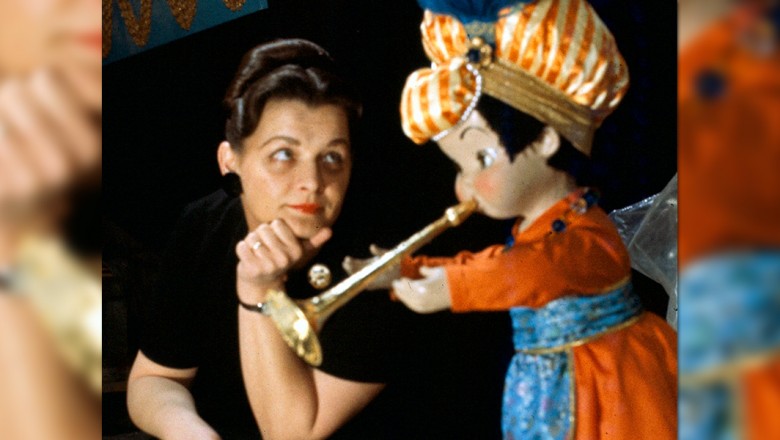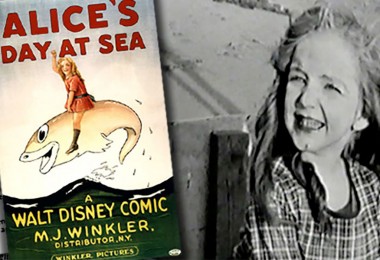Alice Estes Davis instantly makes you feel at ease. Her home, in the Los Feliz section of Los Angeles where she’s lived since the late 1950s, resembles a museum more than a dwelling. Alice, along with her husband and fellow Disney Legend, Marc Davis, moved here not long after they were married, and the rooms are brimming with his sketches and paintings, as well as an impressive collection of wood-carved treasures from Papau New Guinea. We arrive early one Monday afternoon and are greeted not only by Alice, but by her two sweet-natured dogs, Circe “The Enchantress” and Boeing 707 (“Bo” for short). And what starts out as a scheduled one-hour visit turns into a full afternoon of stories, laughter, and fond reminiscences.
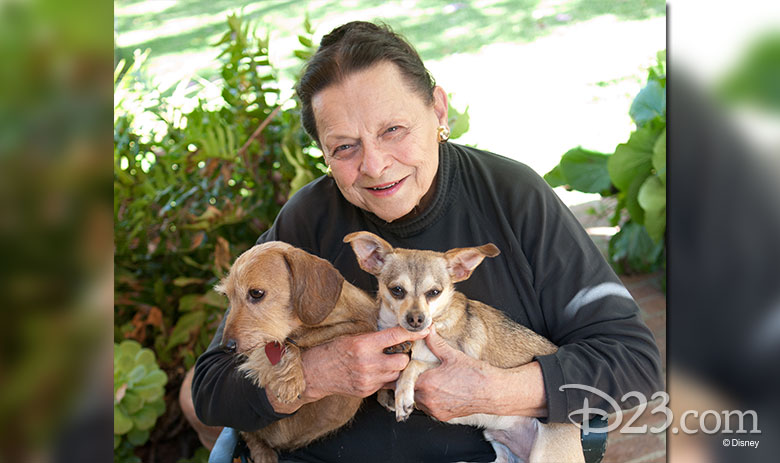
Recalling childhood adventures, such as winning an art contest when she was five, or being taken by her artist mom—who had literally saved her pennies for a month—to see Snow White and the Seven Dwarfs on her eighth birthday, Alice always seems to have a smile in her voice. And her mind is sharper than most 20-year-olds. When asked about her amazing memories, she says, nonchalantly, “They involve people… I love people.” Whether talking about her husband, whom she clearly adored, or working alongside Walt Disney, or about her own remarkable accomplishments—such as designing and creating costumes for the it’s a small world and Pirates of the Caribbean attractions and giving back generously to her community, her stories paint vivid pictures of people and places from days gone by. Alice Davis is a Disney Legend for sure, and she’s also a living treasure.
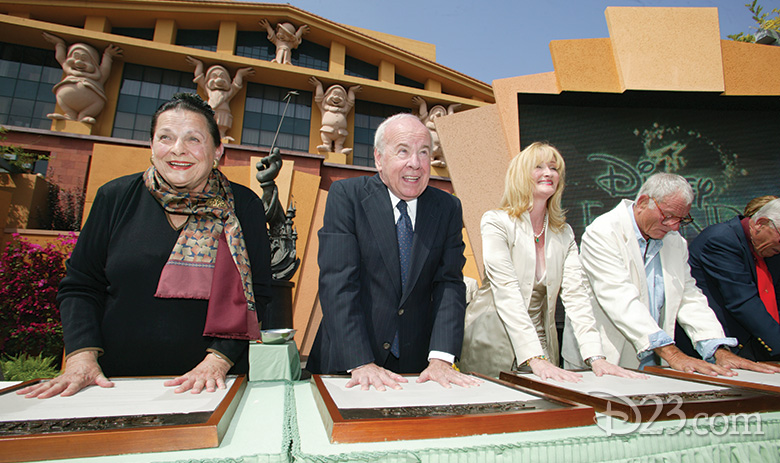
D23: You’ve pretty much been an Angelino all of your life?
Alice Davis (AD): I’ve lived right here for 50+ years. I can get downtown in about 12 minutes. I can get to the Studio in about 12 minutes. I can get to Glendale quickly. And I’ve lived in this area since my family first came to Southern California when I was 4.
D23: Has it changed dramatically since you first moved here?
AD: It sure has! When we moved here, we lived on Franklin, and when you walked around the corner and down a couple of blocks, you were at the Disney Studios with the Mickey Mouse sign on top. But I was born in Escalon. My father was training to be a high school principal. We came to Hollywood when he lost his job. This was during the Depression, and he used to jokingly say, “The Depression had to come, but you had to come too… another mouth to feed.” We moved to Southern California, and the only job he could get was selling life insurance.
D23: So your mom had to work, too?
AD: Yes, she went back to work, and lied about my age so she could sign me up at the grammar school for kindergarten, and she could get a job. That’s when I won the all-city painting competition for children in the Los Angeles school system. I was 5. And you had to be 6 to be in kindergarten. I was tall for my age; I looked 6.
D23: What was the subject of the painting?
AD: It wasn’t modeled after anyone in particular. It’s a painting of a woman wearing a fancy pink dress. She has a black-and-yellow belt and black shoes. They put it on exhibit at a local bank. They had a parade, and I was supposed to walk in front of the parade with the painting on a stick. But I just wanted to be one of the kids. When nobody was looking, I went home and hid in my closet. When it came time for me walk with the painting, I wasn’t there. They didn’t find me until 4:00 that afternoon. Boy, was I in boiling water with my parents!

D23: Did winning that contest inspire you?
AD: I wanted to be an artist. My mother was an artist and taught. She was a tremendous influence on me. She had a huge pair of scissors, and at the age of 1, I was cutting out paper dolls, and everybody who came to the house thought I was going to hurt myself. My mother said, “No, I’ve taught her, and she knows that if she does something she shouldn’t, the scissors will be taken away.”
D23: After high school you were accepted to Chouinard, right?
AD: I won a scholarship. Chouinard was close to where I lived when I was in grammar school. If I walked a couple blocks out of my way home from school, I would walk by Chouinard, and they always had exhibits. I would go in and look through the gallery and tell everybody I was going to go there someday. When I graduated Long Beach Polytechnic, I thought I wasn’t good enough to get a scholarship. But I had a portfolio and my mother came home from work and said, “Did you turn in your portfolio today,” and I said, “No, I don’t think I have a chance.” She said, “You go upstairs and get that portfolio right now!” She put me in the car with the portfolio. There were still lifes, portraits, landscapes, flower arrangements.
D23: Chouinard was made up mostly of men students?
AD: Oh was it! Fortunately for me Mrs. [Nelbert] Chouinard was helping sign up some of the students, including me. She said, “We have GIs coming back from the service, and this is their second chance to get a decent job and be an artist, so we won’t be able to get you in for two years.” I’m not a weeper, but I started to cry. I told her I wanted to be an animator. She said only men are in animation class. I said, “I can’t understand that. I was raised to understand that if you were capable of doing a job, it didn’t matter whether you were male or female.” She smiled and said, “I think that way too.” She left and came back with a woman in a white smock with a tape measure around her neck. They looked at me, whispered, and left. Mrs. Chouinard came back and said, “You’re starting school Monday, and you’re going to be a Costume Design major.” That’s how I became a costume designer. I called Mrs. Chouinard “my mother away from home.” We were friends until she passed away.
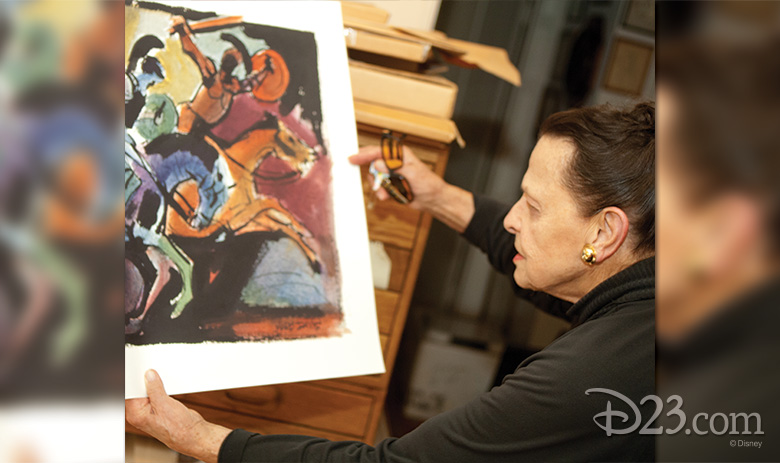
D23: You must have been very happy even though that wasn’t the course of study you were expecting?
AD: I was, especially since you had to take Fine Art the first year. But I didn’t know anything about clothes. When Mrs. Chouinard signed me up for classes, she said, “We have a new teacher, Mr. Marc Davis. He’ll be teaching Animation Drawing. She said that he would teach how the figure works, how muscles stretch, and so forth. And you have to learn to draw everything. You’ll have a sketchbook and sketch all the time.” She said the class is Tuesday nights, and if I take two perfect pieces of white chalk for Mr. Davis to do his lectures, she’d let me take the class free. It was a marvelous class; it helped me more with costume design than any costume class I ever took. When I left Chouinard, my first job was designing brassieres and girdles and lingerie. I knew exactly how the legs worked and how muscles would make clothes work.
D23: How did your relationship with Marc evolve?
AD: After I’d graduated and went to work, a friend called me. Her fiancé, who’d been in Marc’s class, was going to Mexico to study sculpture, and she was giving him a going-away party, but he wouldn’t go unless Marc was there because he was the teacher whom he most respected. The only person my friend knew who knew Marc was me, so she called me and asked if I’d invite him to the party. I said, “Sure, I can ask him.” I told Marc to bring a date and gave him the address. He came by himself. The next night, he called to thank me for inviting him and say how much he enjoyed seeing the students. He asked if he could thank me by taking me to dinner. So we went to dinner. He had lots of lady friends, and I was busy working so I figured that was that. But he started calling me, and we started going out regularly. We got to be good friends, but he got angry because I kept calling him Mr. Davis. He said, “My name is Marc!”
D23: How long before you got married?
AD: We didn’t get married until I was 27, in 1956.
D23: When did you first meet Walt?
AD: We bought a house in 1957. While Marc was working, I was stripping wallpaper off walls, things like that. I called Marc and told him I was tired, how about we go out to dinner at the Tam O’Shanter. He said, “Fine.” We were having a cocktail and this hand came on Marc’s shoulder. I looked up and just about swallowed my glass. It was Walt Disney. He said, “Marc, is this your new wife?” Marc said “Yes,” and Walt pulled up a chair. He joined us for a cocktail and asked what I did professionally. He was very curious. When he heard me say “elastic,” he wanted to know all about elastic fabric. He stayed for at least a half hour, asking me all kinds of questions. Marc was sitting there wondering what was up his sleeve. Eventually, he said, “Well, I’d better get going.” He started to walk away, then turned and said, “You know, you’re going to work for me someday.” He said goodbye and left, and I remember thinking, “Oh, sure, sure.” Years later, I got a call from Walt’s secretary who said, “Alice, Walt wants to know if you’d like to do the costumes for small world.” And I said, “Would I!” She said, “Be here at 9:00 tomorrow morning.”
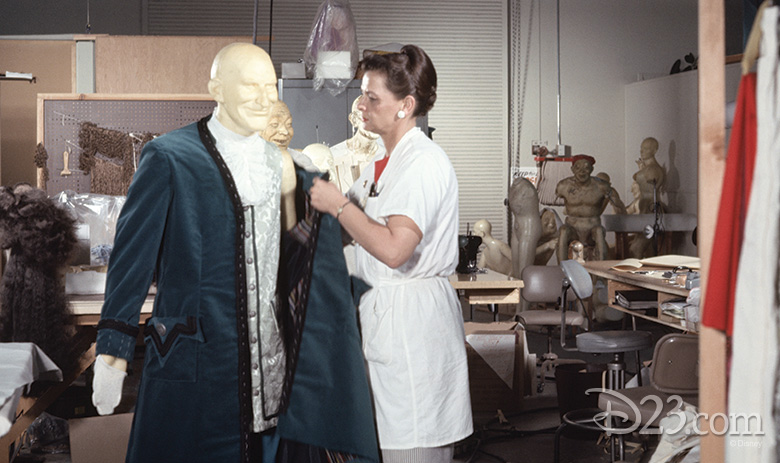
D23: You weren’t still working at the lingerie company anymore?
AD: No. I had a couple jobs after that before Marc and I were married. The companies hired me because at Chouinard, you had to be able to do children’s clothing, women’s clothing, men’s tailoring. This was Walt’s thinking, too, because I could do patterns for children’s clothes, women’s clothes, and men’s clothes. I could sew them and put them together. But I also had a fine art background. Anyway, Walt knew he’d have somebody who knew the whole system for the Audio-Animatronics® figures. Plus Marc was working on it, and I could do the costumes. Later, the only figure Walt saw for Pirates that was finished and working was The Auctioneer. Then, a day or so later, he went into the hospital. He never saw the finished Pirates ride. But he’d been very excited about it. And I did the costumes for that show.
D23: What was your first assignment at Disney?
AD: Walt didn’t know that I’d worked for him before Marc and I were married. My first job was when Marc was doing Sleeping Beauty. He was doing Aurora dancing in the forest with the prince. For live-action reference, he wanted the skirt to take a shape and turn, and Marc knew that I knew what he was talking about because I’d been in his animation class. So I designed it.

D23: You didn’t start working for WED until 1962, many years later. What was your first formal job there?
AD: Small world. I had one year to do the whole thing. Design the costumes, start doing the patterns. When Marc and I went to New York in 1956 on our honeymoon, I got to meet Mary Blair. I adored her work from the time I was in junior high. When I met her, I lost my speech. The best part is we became good friends, and I was able to work with her on small world.
D23: Did your image of Walt change over the years?
AD: When I first met him at the Tam, he was very gracious, and when he sat down to talk, you could see how brilliant he was. Always thinking ahead. You could feel the machinery going. He could do idle talk and make conversation, but there was always a question somewhere. Over time, you realized his mind was like a steel trap.
D23: Didn’t Walt like to have various concepts to consider?
AD: Yes. If he asked for an idea for something, Marc would give him at least three or four, or three or four drawings. So Marc was training a young man at WED [now Imagineering]. This guy was excited about an assignment, and he came to Walt with one painting for the idea. Well, Walt looked at it and got that questioning look on his face. He said to the young man, “This is very interesting, but it’s very difficult to choose between one.” He was letting him know gently. But if he did the same thing twice, it wouldn’t be so gentle.
D23: When you and Marc were working at the Studio, was there shop talk in the Davis household?
AD: Marc tried not to talk about it at home. When he’d come home, he’d ask me what was on television that night… An opera? A rodeo? A circus? And he always had a sketchbook. He would sit and draw while he was having his cocktail and talking. What marvelous sketchbooks! Circuses were always fascinating him. He would draw everything as fast as it happened. He always insisted that he’d never tear a page out of a sketchbook. Even if he had drawings he didn’t like, he left them in. He said that’s how you’d know if you’re keeping up with yourself. Never take yourself for granted.
D23: What was the working environment like at the Studio in those days?
AD: It was the best job I ever had because there were no class distinctions. Everybody had a job to do. None of us had titles. We all went by first names. And we all worked for the same thing: putting on the best show possible. We’d be at work before we had to be, and we’d stay as long as we had to. Walt would come in and say, “That’s looking good,” or he’d say, “That’s a good idea but it doesn’t work as well as we thought it would. What if we did thus and so…” Then he’d say, “How long do you think it’ll take to get that ready?” If you said, “Next Tuesday,” he’d say, “Fine, I’ll be back at 1:00 Tuesday.” He never wrote anything down, but at 1:00 the next Tuesday, he’d be there, and you’d better be there too!
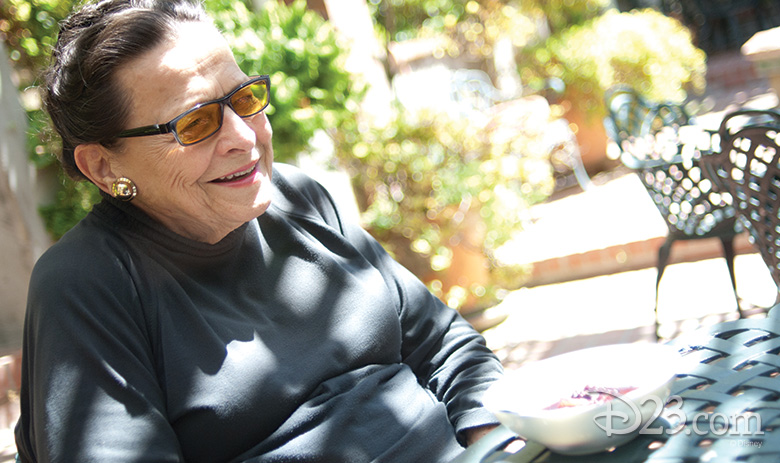
D23: Your mother was a great influence. Were there other teachers or mentors, too?
AD: I had lots of good teachers, but I also had people who saw that I wanted to be an artist, and they liked helping people. I always say that good friends are the jewelry of your heart. They’re your riches. The jewels of your heart are your friends. If you don’t have friends, you can have all the money in the world, but you’re not happy. You can be poor and have lots of friends, and if nothing else, you can sit on the side of a hill and enjoy the sunset with a bottle of wine and a loaf of bread and be happier than any rich person. Because you have all these riches around you.
D23: Walt was really inspired by all kinds of things?
AD: Here’s an interesting story. Marc would sometimes stay at his desk and get books on fine arts down at the Studio library and read them on his lunch hour. Walt came in one time when Marc was looking at one of these books, one on Salvador Dali, and Walt looked at it and saw the abstract and the realistic parts mixed together. He said, “Who is that?” Marc told him and started explaining some of the things in the book, and Walt was intrigued. He thanked Marc for letting him disturb his lunch. A day later, Walt’s secretary called and said that Walt wanted to borrow the Dali book. Before he knew it, Dali was working at the Studio. And it all started with Marc reading that book and Walt being curious.
D23: Though you didn’t end up being an animator, you went in a different direction and were very successful. You must be proud of that?
AD: When I’m asked to talk to students, I tell them, there are a lot of courses you’re asked to take, ones you might think you don’t need. I tell them to take everything they tell you to take. I didn’t think I needed Children’s Fashion or Men’s Tailoring. I took them and worked hard. I tell students to take everything, because you never know: The one thing you think you don’t need could be the one that’s going to get you where you want to go.
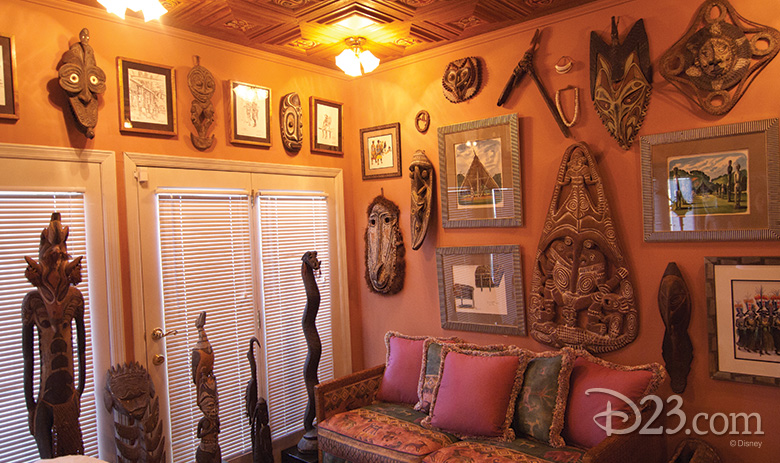
D23: Your house is filled with art from New Guinea. Why does it appeal to you so much?
AD: Marc and I started collecting New Guinea art as soon as we could afford it. We went twice and we stayed with the tribes. What appeals to me about them as people is that they are all individuals. The way they put feathers in their hats is all different, the hats are all different, their skirts are all different, no two necklaces are alike, but yet when they all stand together, you can see they are one unified group. They believe they are descendants of crocodiles, and they have beautiful patterns carved on their chests, on their arms, on their backs… each one is a creative person, a designer in their own right.
D23: Is there anything we might have left out?
AD: I get angry reading negative things about Walt. He was a joy to work with and for. There was all kinds of freedom, mentally as well as physically. When I was pressed on small world, I was allowed to come in to work weekends. I didn’t have guards looking over me. Meeting Walt and working for him was one of the pleasures of my life. He was the best boss you could have. My husband would agree and said it best: Working for Walt Disney was the best school he ever attended.


